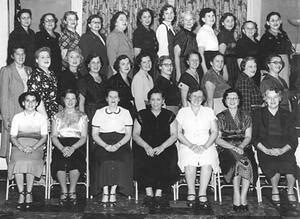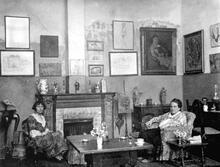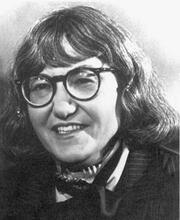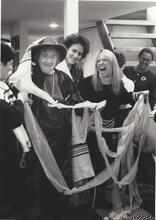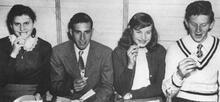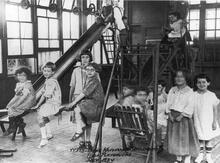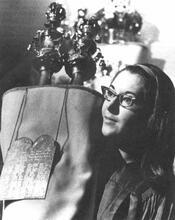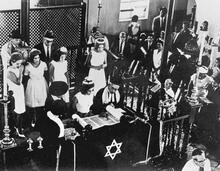Assimilation in the United States: Twentieth Century
The "Yankee" Jewish women of the first half of the twentieth century created the infrastructure of American-Jewish women's organizational activities. The founding of synagogue sisterhoods began with the Reform National Federation of Temple Sisterhoods in 1913, followed by the Women's League for Conservative Judaism in 1918, and the two Orthodox sisterhoods, Mizrachi Women’s Organization of America (AMIT) in 1925 and Emunah in 1935. Pictured here is the Orthodox Congregation B'nai David Sisterhood of Detroit, Michigan, ca. 1950. Among those seated are Rebbetzin Yetta Sperka (top left), wife of the synagogue Rabbi Joshua Sperka; Mrs. Hyman Adler (top right), wife of the congregation's cantor; and Mrs. David J. Cohen (second row, center).
Institution: Ahava Rivka Sperka.
Jewish women assimilating into a changing American society across the twentieth century navigated often opposing gender roles. As they strove to achieve upward social mobility, they adapted Jewish assumptions of what women, especially married women, should do to accommodate American norms for middle-class women. Their collective accomplishments registered in political activism, organizational creativity, strong support for feminism, religious innovation, and educational achievement in the face of antisemitism, stereotypes, and denigration. Immigrant mothers and their daughters interpreted American demands for adjustment differently, leading to conflict over the right path to follow. Later generations of Jewish American women challenged both American and Jewish expectations of gender roles, rewriting the script of assimilation by the end of century.
Introduction
Immigrant Jewish women began to assimilate into American society and culture as soon as they stepped off the boat. Some started even earlier, with reports and dreams of the goldene medine, the golden land of liberty and opportunity. Young women especially envisioned a country where they could choose their own husband. Others dreamt of getting an education. Very few resisted adopting the language and mores of the United States as they encountered them; those who did often returned to Europe. Well over ninety percent stayed, even those who cursed Columbus’s voyage and subsequent European settlement in North America. In their choice of paid employment and household labor, their attitudes toward love and marriage, and their methods of child rearing, immigrant women provided the first models of American Jewish womanhood for their daughters.
If assimilation began with immigration, it did not stop with the maturation of a native-born generation. Studies of assimilation often focus on the children of immigrants born in America or brought over when young: the second generation. Their attitudes and behavior in comparison to their immigrant parents reveal the extent of their adaptation to the United States and commitment to a distinctive Jewish way of life. Similarly, the third generation, with immigrant grandparents, often offers a touchstone to vouchsafe whether Jews and Judaism can survive in freedom. How these generations speak, eat, earn a living, vote, dress, observe religious practices, and rear their children, not to mention where they live and whom they marry, are data to interpret their assimilation.
A continuum exists between Jews whose distinctiveness from other Americans appears in each of these categories of daily life and Jews who resemble their fellow Americans in everything except name or self-identification as a Jew. Often stages are postulated on the path of assimilation, suggesting that some changes—such as language, dress, education, and ways of earning a living—precede other, more complex changes—such as those involving family, including religious observance and choice of marriage partner. Occasionally, a generation may swerve from its path, unwilling or unable due to antisemitism to continue to adapt. Even more rarely, members of a generation may reverse their steps, moving away from assimilation toward greater Jewish distinctiveness.
Scholars of assimilation disagree in their interpretations of Jewish assimilation in America. Initially many posited a straight-line path to complete assimilation: They expected Jews to disappear as a separate group in American society. For them, intermarriage or structural assimilation was the final step. Others argued for assimilation’s transformative power, suggesting that the process of adaptation stimulated Jews to acquire and invent new ways to maintain their identity in America. Still other scholars posited Jews as a symbolic social group, discounting the significance of religion and ethnicity. Some emphasized the importance of religious distinctiveness, seeing Jews as non-Christian dissenters in America; in their eyes, religious observance achieves primacy over marriage partner. Almost all agree that politics, place, and period influence assimilation, and that assimilation is an interactive process involving Jews on one side and non-Jewish Americans on the other. Both sides change.
Riv-Ellen Prell’s study of gender and Jewish assimilation in the twentieth-century United States uncovered the significance of shifting American gender norms. Aspirations for social mobility exacerbated conflict between Jewish men and women. Her scholarship, building upon pioneering work by Paula Hyman, reveals the “anxiety of assimilation,” how Jewish women and men negotiated tensions that flow from trying to accommodate and adapt American gender ideals to Jewish realities. She details the production of stereotypes, from “ghetto girls” to “Jewish American Princesses,” that have maligned Jewish women across the twentieth century.
Since immigration initiated the process of Jewish assimilation in America, the concept of generational change remains useful. Second-generation Jewish women, growing up in immigrant households but attending public schools, speaking English with access to American popular culture, encountered at least two different understandings of gender roles. Their mothers embodied diverse dimensions of Jewish womanhood; their teachers and popular female cultural figures represented American womanhood. Daughters often struggled to develop an American Jewish womanhood bridging these differences, acceptable to themselves and their mothers.
Fewer dissimilarities existed between second-generation mothers and their third-generation daughters because the former spoke English, had studied in public school, and often were middle class. As a result, both mothers and daughters tended to agree on acceptable gender roles. Friction returned with the third and fourth generations. When, through the rise of 1960s feminism, Jewish women successfully challenged American definitions of appropriate gender roles, they occasionally provoked conflict with their mothers.
If generation removed from immigration helps locate Jewish women in the assimilation process, it provides neither chronology nor historical framework for social, cultural, and religious change.
Over the course of the twentieth century, four different, overlapping cohorts of Jewish women can be identified. Their paths of assimilation suggest alternative ways of defining American Jewish womanhood. The first group of women came of age during the Progressive Era of the late nineteenth and early twentieth centuries. Their parents emigrated during the nineteenth century, many of them from Central Europe; a few descended from old Sephardi families. The second cohort grew to maturity during the Great Depression. Their parents were part of the mass immigration of Eastern European Jews that ended in 1924. The third group reached adulthood during the era of the Cold War and Civil Rights Movement. Their parents usually were native born, although some were the children of refugees from Nazi Europe and survivors of the Holocaust. The last cohort grew up at the end of the century, never questioning their American identity, usually with native-born parents and grandparents. Many scholars argue that this cohort offers the best evidence of Jewish assimilation in America.
Coming of Age During the Progressive Era: 1900–1960
Autobiographies suggest that this group of American Jewish women grew up well integrated into their Jewish families, comfortably embedded in American communities scattered throughout the United States. Many enjoyed luxuries of middle-class family patterns in which mothers managed the household, often with the assistance of servants, and children received an education. Despite a lack of zeal among Jews to educate daughters as they did their sons, Jewish girls benefited from expanding educational opportunities for American women. Many went to high school or normal school; a handful of determined women like Jessica Blanche Peixotto or Fannie Hurst attended college.
The women’s movement expanded horizons for middle-class white women, including Jewish women. Ballots, birth control, and the peace movement drew women into the public sphere. Many Jewish women supported woman’s right to vote. They also recognized that their lives did not need to be constrained by marriage and motherhood. Social feminism, the idea that woman’s particular strengths in caring for the vulnerable required that she leave her home and enter public life, attracted many Jewish women and provided a rationale for organizational activity.
Progressive American Jewish women created most of the national, mass membership Jewish women’s organizations of the twentieth century. A sense of security as American Jews coupled with a desire to improve the world and educate themselves propelled this group into the mainstream of American women’s activities. They joined the club movement as did Hannah Solomon. They developed the settlement house movement as did Minnie Low and Lillian Wald. They helped spark the consumer movement like Helene P. Gans. They championed birth control, as did Jennie Franklin Purvin. Together with such leaders as Ella Altschuler and Zerlina Hirsh Bilder, they supported the peace movement.
At the same time, these progressives established organizations to change the Jewish world. In large cities, especially New York, they encountered both Eastern European Jewish immigrants and immigrants from the Ottoman Empire, whose distinctiveness set them apart from other Americans. These experiences prompted efforts to help by alleviating poverty and teaching American ways of living. Some progressives saw immigrants as needy cousins, while others feared that their poverty and radicalism might incite antisemitism. For a woman like Josephine Lazarus, meeting immigrants inspired a romantic identification with Jewishness that strengthened her commitment to live as a Jew. For a woman like Tamar de Sola Pool, born in Jerusalem but educated in New York, helping Sephardi immigrants specifically complemented her dedication to creating a more just world that bridged differences among Jews. The label “Sephardi,” applied to diverse migrants from the Ottoman empire and the Middle East, some speaking Ladino, others Arabic, represented one of the first important steps in assimilation for these Jewish immigrants. It forged a bridge among the newcomers and connected them to older, established New York Jews, members of Shearith Israel, the city’s first Jewish congregation dating back to the seventeenth century.
The National Council of Jewish Women (NCJW), an organization that took up the challenge of helping immigrant Jewish women, appeared first in 1893. Hadassah, the women’s Zionist organization, followed in 1912. Then came the founding of synagogue sisterhoods, first the Reform National Federation of Temple Sisterhoods (1913), followed by the Women’s League for Conservative Judaism (1918). Later, Orthodox women established the Mizrachi Women’s Organization of America (1925, today known as Amit) and the Emunah sisterhood (1935), religious Zionist organizations for North American women and for worldwide membership, respectively.
The diversity of Jewish women’s organizations reflected differing religious and ideological stances. A commonality of belief in voluntarism and the power of women working together in women’s organizations united them.
Organizational activism represented only one response to changing gender roles. Other Jewish women grasped opportunities to pursue careers to further individual dreams as writers, artists, lawyers, scholars, educators. A few, like Blanche Wolfe Knopf or Zelda Popkin, transformed Jewish women’s traditional economic activity as partner with her husband in business (usually some form of commerce or manufacture) into a modern occupation previously closed to women—in the case of Knopf, as director of the publishing firm Alfred A. Knopf, and of Popkin in the field of public relations.
An open and optimistic society in the United States dissolved conventions constraining determined and talented Jewish women who sought alternatives to marriage and motherhood. Facing relatively few obstacles specific to Jews, these women forged personal careers. For many, such goals took them away not only from any Jewish distinctiveness but even from any Jewish identification. Writers as different as Gertrude Stein and Thyra Samter Winslow shaped cultural worlds for themselves that relegated Jewishness largely to a fact of birth and upbringing.
Others found inspiration in their Jewish background that encouraged them to pursue political and social activism. Figures like Jeanette Goodman Brill, who served as a municipal judge in New York City, and Julia Richman, who was the first woman to serve as an assistant superintendent of New York City’s public schools, felt an intimate connection between their desire for careers in public service and their Jewish heritage. Still others, like Tehilla Lichtenstein, co-founded a new religious movement, Jewish Science, designed to offer an alternative the Christian Science and its appeal to American Jews. For them, new gender roles available to women—both married and single—did not translate into a form of assimilation that distanced them from other Jews or the Jewish community.
While only a minority built the infrastructure of Jewish women’s organizations or pioneered in developing new careers for women, their significance outweighs their numbers. They established important precedents for masses of second-generation American Jewish women coming of age during the Depression. These included a tradition of American Jewish voluntarism and activism accompanying marriage and child rearing, as well as recognition that talent and perseverance could bring rewards of independence. By their activities and presence, leaders of this progressive cohort indicated possibilities available to American Jewish women. Middle-class women could achieve individual expression and fulfillment. The personal sacrifices were less obvious.
The majority married Jewish men and raised children, confining their activities to socializing within their class. Their Jewish religious observance usually occurred at home on holidays and important times during the life cycle. Many enthusiastically celebrated American holidays, especially Thanksgiving, and a minority, Christmas and Easter. Reform Judaism appealed to most as an American form of Judaism. In keeping with their middle-class position and urban residence in the Northeast, Midwest, and far West, this cohort usually supported the Republican Party’s progressive wing when they received the vote. For most, Judaism was a family matter, not an issue of ideology or ethnicity. However, their children discovered anti-Semitic discrimination rather than an open society.
Coming of Age During Depression and War: 1930–1990
In contrast to the thousands of Jewish women in the progressive group, the millions of women who grew up during the Great Depression and World War II changed the character of their assimilation. For example, following in Julia Richman’s footsteps, thousands of Jewish women joined the ranks of New York City public school teachers. By the 1940s and 1950s, Jewish women were the vast majority of all public school teachers in New York City, which at that time had the world’s largest public school system. As a result, Jewish teachers discovered that their essentially American occupation brought them into daily contact with other Jewish women. Their collective assimilation made teaching a distinctively Jewish vocational choice—New Yorkers called teaching “the Jewish profession.” Their numbers simultaneously swelled the ranks of active unionists.
Wholesale adoption of birth control by this cohort of women dramatically reduced the Jewish birth rate from one of the highest among immigrant groups to one of the lowest among urban ethnic groups. These Jewish women made low fertility a characteristically Jewish attribute, along with a high marriage rate of over ninety percent. In politics, they enthusiastically supported New Deal liberalism, especially its internationalism and social welfare policies, and championed the cause of labor. Some leaned further left, favoring Socialism and Communism, at least until the Cold War made such politics dangerous. In many ways, this cohort overshadowed the singular achievements of the progressive group. New patterns established came to be considered typically American Jewish gender roles, obscuring earlier alternatives as well as significant internal differences among Jews, especially between majority Ashkenazim and minority Sephardim. Intermarriage between Ashkenzim and Sephardim occurred rarely, helping to strengthen a double minority consciousness among the latter.
Yet the women of World War II found far fewer options available than their predecessors. Society became more restrictive for Jews. Even as women achieved the right to vote in 1920, Congress limited immigration through legislation designed to reduce decisively the number of Eastern European Jews entering the country. Patterns of anti-Semitic discrimination spread to include exclusion of Jews from schools of higher education, white-collar employment, and residential neighborhoods. Substantial obstacles prevented Jewish women from assimilating into American society. For example, job placement agencies occasionally admitted that “it was a waste of time to send Jewish women to the New York Telephone company and to the large insurance companies.” In contrast to public school teaching, “it was common knowledge that ‘the phone company was part of the Catholic Church,’” as stated by Ruth Markowitz in My Daughter, the Teacher. Newspapers regularly ran job advertisements explicitly stating: “Christians only.”
Most of the women of World War II grew up in working-class homes in large urban neighborhoods—New York City and Chicago accounted for half, and 75 percent lived in just five cities. They shared crowded apartments with brothers and sisters. Ambitious and eager to achieve independence, they found themselves tied to family responsibilities, their horizons hemmed by neighborhood boundaries. Immigrant mothers expected daughters to help them; only those who enjoyed a modicum of economic security could afford to encourage their daughters to seek individual fulfillment. Pathways out of the neighborhood through education, employment, and talent existed, but reaching them often required extra measures of determination and ambition.
Given the obstacles, impressive numbers of Jewish women succeeded in such diverse fields as art and science, literature and law, politics and business, as well as entertainment and education. They include outstanding figures like Nobel Prize winner Rosalyn Sussman Yalow and U.S. Supreme Court justice Ruth Bader Ginsburg. Jewish women also shaped the growing field of Jewish education, writing history books and retelling Bible stories, filling the ranks of Sunday and Hebrew school teachers, and contributing to the popularity of Lit. "dedication." The 8-day "Festival of Lights" celebrated beginning on the 25th day of the Hebrew month of Kislev to commemorate the victory of the Jews over the Seleucid army in 164 B.C.E., the re-purification of the Temple and the miraculous eight days the Temple candelabrum remained lit from one cruse of undefiled oil which would have been enough to keep it burning for only one day.Hanukkah as an American Jewish holiday alternative to Christmas.
This cohort of Jewish women produced a substantial body of American Jewish literature. Diverse Jewish women’s voices, from the earthy stories of Grace Paley to the class conscious ones of Tess Slesinger, allowed not only for individuality to emerge but also for a sense of common concerns. Among recurring themes is the tension between mothers and daughters, the struggle to find one’s own voice and one’s own way of expressing American Jewish womanhood, as in Tillie Olsen’s poignant novella, Tell Me a Riddle. Few writers seek to replicate their mother’s Jewishness, whether that appears in the form of a competent baleboste (household manager) or a dedicated radical. Instead, they strive to articulate a new way of understanding motherhood, marriage, and what it means to be an American Jewish woman.
The desire to be part of mainstream American society remained strong among this group, perhaps because of difficulties gaining access and acceptance, although World War II exerted a powerful transformation in Jewish women’s lives. Substantial numbers of Jewish women volunteered for military service in World War II when the armed forces opened opportunities for women. Although they encountered prejudice in the ranks, they also experienced the military’s affirmation of Judaism as one of the three fighting faiths of democracy. Other women organized to stay in touch with their men, writing regularly, sending packages of food, raising funds to purchase war bonds. In Brooklyn, young Syrian Jewish women, many the first generation to graduate from high school, created a monthly newspaper, The Victory Bulletin. In addition to keeping connected with their men in uniform, it chronicled and advocated for changing religious, political and social conditions among Syrian Jewish women. Yet, when barriers fell in the postwar decades and Jewish women received recognition for their individual accomplishments, many discovered that their self-consciousness as outsiders endured despite new respect and influence.
For the vast majority who retired from paid employment upon marriage or the birth of their first child, American Jewish womanhood meant blending middle-class mores with a modified Jewish traditionalism focused on family and community. Even the minority who received a college education assumed that their lives should focus on fulfilling the duties of wife and mother. Their decision to leave paying jobs to marry and raise children reflected their acceptance of American gender norms. Immigrant Jewish women assumed that they would have to contribute to the family income, though they rarely did that by taking work outside the home—a pattern their daughters rejected as soon as feasible.
Most of the women of World War II shouldered responsibility for passing on Jewish traditions to their children despite their own lack of formal Jewish education. Here, again, they adopted American mores that placed religion within the feminine domain. Since they knew very little about Judaism, though they accepted religion as the basis of Jewish distinctiveness, they usually turned to Jewish professionals to give their children a Jewish identity. This meant joining a synagogue, usually a Conservative one, when children were old enough to attend Hebrew or Sunday school. It also meant sending their children to camp if they could afford it. Increasingly women attended synagogue services, especially on holidays, sitting together with their husbands and children. As mothers, this generation prepared Jewish foods learned from their mothers, though only a minority maintained kosher kitchens.
The tradition of volunteer activism previously established took hold as the women of World War II acquired suburban homes and a measure of affluence. Jewish women flocked to join Hadassah, NCJW, the synagogue sisterhoods, as well as smaller national women’s organizations like Women’s American ORT, the American Jewish Congress Women’s Division, B’nai B’rith Women (now Jewish Women International), and Pioneer Women (now Na’amat). Their numbers swelled the organizations’ membership lists. Through these organizations they gained an education in politics and ideology, as well as practical experience in fund-raising and political action, and leadership training for those who desired it.
Like their predecessors, these Jewish women also joined Parent-Teacher Associations and a variety of secular American voluntary organizations. Many enjoyed socializing with female Jewish friends at home over cards or mah jongg, coffee and cake. When Betty Friedan discovered “the problem that has no name” in 1963 and its cure (feminism), Jewish women joined the National Organization for Women. Many subsequently decided to return to the paid labor force after their children left home; a minority continued to work outside the home throughout their lives.
Gender roles adopted by the women of World War II, even by those who felt they had no opportunity to choose, reflected their eagerness to become American women and their discovery that they remained Jewish women. Antisemitism and the Holocaust slowed their trajectory of assimilation. As the poet Muriel Rukeyser testified in her poem, “To be a Jew in the twentieth century” was both a burden and a gift, but neither could be refused without terrible cost. The cultural critic Susan Sontag also bore witness to the Holocaust, writing many years later of “a negative epiphany” upon seeing photographs of the concentration camps. “Indeed,” she writes in On Photography (1977), “it seems plausible to me to divide my life into two parts, before I saw those photographs (I was twelve) and after.” Even when antisemitism eased in the postwar period and the State of Israel offered an alternative image of Jews other than that of victims, few American Jewish women of this cohort dissociated themselves from other Jews or from an identity as a Jew.
Yet unlike their mothers, the women of World War II suffered from stereotypes widely purveyed in popular culture. Produced and popularized largely by men, often their sons but occasionally their husbands, the stereotypes mocked these American Jewish women as the epitome of nouveau riche crassness. From their mink coats and jewels to their ornate taste in home furnishings, to their overladen tables of food, to their enthusiasm for fund-raising to help suffering Jews in Israel, to their child-rearing patterns that induced guilt but avoided physical violence, to their ambitions for their sons and daughters, little in their way of life was not a potential target of mockery. Only with the rise of Jewish feminism in the 1970s did a re-evaluation begin of the women of World War II.
Baby Boomers: 1950–2000
Until the last decades of the twentieth century, the baby boom generation served as the touchstone of Jewish assimilation in America. This first cohort included large numbers of third-generation Jewish women, as well as second- and fourth-generation, together with children of refugees (not only German and Austrian Jews but also Hungarian Jews and Cuban Jews) and Holocaust survivors. Such mixed sources for a generation enrich and complicate assessment of assimilation.
In addition, in 1965, the United States liberalized its immigration policies, opening possibilities for increased numbers to enter the country. Jews from the Soviet Union, South Africa, Iran, Cuba and South America migrated to the United States, forming distinctive concentrations in a number of American cities and suburbs. For these immigrants and their children, the process of assimilation began in the 1970s and 1980s during a time when the new ethnicity and multiculturalism achieved popularity. When Lucette Lagnado chronicled her transformation from Egyptian daughter into successful American journalist, she penned not a typical story of assimilation’s triumphs but rather an account of a longing to return.
Several million strong, the baby boomer generation’s social and cultural patterns provided critical data to interpret the meaning and character of Jewish assimilation in the United States. The women of World War II remained ethnically Jewish in their social and family life, as well as in their occupational and residential patterns. As the group bearing witness to the two outstanding Jewish events of the twentieth century—the destruction of European Jews and the establishment of the State of Israel—it remained bound to its Jewish identity. By contrast, many baby boomers grew up in a society of suburban comfort that included the luxury of privacy and a room of one’s own. In their world Israel was an accepted reality and few paid serious attention to prewar Ashkenazi and Sephardi Jewish culture. Instead, the Holocaust itself increasingly became a touchstone of Jewish identity, albeit interpreted through an American perspective.
Education, including college and postgraduate study, became an accepted norm for Jewish daughters as well as sons. Jewish women discovered opportunities for self-expression, careers, and individuality. A 1990 survey found almost sixty percent of Jewish baby boomers employed full time and only four percent not employed. Few obstacles impeded their assimilation. Residential, occupational, and educational discrimination against Jews, vigorously opposed by their parents, gradually lessened. As such antisemitism declined, Jews increasingly enjoyed the privileges of whiteness and the benefits of an American society that enshrined white supremacy.
Ironically, as if to foreclose opportunities, a new stereotype of the Jewish American Princess (JAP) appeared that diminished and mocked young affluent Jewish women. Propagated largely by Jewish men, it condemned Jewish women for their conspicuous consumption, sexual frigidity, and eagerness to ensnare Jewish men in soulless marriages.
Jewish women faced a United States that more closely resembled the one encountered by the early twentieth century cohort than the America their mothers knew. As Jewish women actively sought to create a more equal United States, first through the Civil Rights Movement and then through a second women’s movement, assimilation’s contours changed. Antisemitism declined dramatically. In 1973 the Supreme Court legalized abortion.
Unlike their predecessors, baby boomers received a formal Jewish education. A significant minority became Bat Mitzvah, a new ritual initiated in 1922 by Judith Kaplan, daughter of Rabbi Mordecai M. Kaplan, to mark the coming of age of their daughters, just as bar mitzvah symbolized a son’s maturity. As feminism became a popular political movement, women who had acquired Jewish learning began to press for equal access to positions of Jewish leadership, including the rabbinate. The first women rabbis came from this generation. In 1972 the Reform seminary ordained Sally Priesand the first woman rabbi in the United States. Two years later Sandy Eisenberg Sasso received ordination by the Reconstructionist Rabbinical College. Both were products of changing American gender roles and expanding Jewish education for women that helped to fuel a Jewish feminist movement.
Other women, like Shoshana Cardin, who became the first woman elected to head the Conference of Jewish Federations, sought leadership positions within the Jewish communal infrastructure. Some women expressed dissatisfaction with positions in separate women’s organizations; others attacked the tradition of voluntarism enthusiastically embraced by the women of World War II. Such battles between two groups of Jewish women reflected the impact of the new women’s movement and its challenge to previously accepted gender roles, exactly those adopted by the women of World War II. Baby boomers did not categorically reject marriage and motherhood—in fact, a majority married and bore children—but they did question patriarchal assumptions behind relegating women to such tasks and then subordinating them.
A smaller number of radical lesbian feminists challenged the entire notion of the heterosexual family and argued for new understandings of the family based on love, commitment, and caring rather than sexuality. A few, like Shulamith Firestone, authored a radical critique of patriarchy, calling for its destruction. Some, like Irena Klepfisz, also turned to the Jewish community, demanding recognition and inclusion. Changing gender roles available to American women, often promoted and initiated by Jewish women, registered forcibly within Jewish institutions.
Most baby boomers were too busy pursuing careers, participating in politics—from mainstream parties to those of the New Left, from various factions of the feminist movement to neo-conservatism—and eventually marrying, to seek leadership positions within Jewish life. Opportunities available to them as talented, highly educated, hard-working, articulate women led many to ignore most Jewish issues, except for Israel and the Holocaust. Integrating easily into American life, benefiting from programs of affirmative action, moving out of areas of Jewish occupational and residential concentration to jobs and homes throughout the United States but particularly in California and Southern cities, they increasingly distanced themselves from their youthful family networks.
Many found such freedom exhilarating; others regretted the loss of Jewish connections but did not return to patterns of the previous generation. In ever-increasing numbers, they chose to marry non-Jews, breaking radically with earlier traditions but aligning their behavior as women with that of Jewish men. In the homes they created, Jewish observance centered almost exclusively around holidays. A seven-day festival to commemorate the Exodus from Egypt (eight days outside Israel) beginning on the 15th day of the Hebrew month of Nissan. Also called the "Festival of Mazzot"; the "Festival of Spring"; Pesah.Passover and Lit. "dedication." The 8-day "Festival of Lights" celebrated beginning on the 25th day of the Hebrew month of Kislev to commemorate the victory of the Jews over the Seleucid army in 164 B.C.E., the re-purification of the Temple and the miraculous eight days the Temple candelabrum remained lit from one cruse of undefiled oil which would have been enough to keep it burning for only one day.Hanukkah, which could be celebrated at home, were the most popular, outranking the previously popular high holy days of The Jewish New Year, held on the first and second days of the Hebrew month of Tishrei. Referred to alternatively as the "Day of Judgement" and the "Day of Blowing" (of the shofar).Rosh Ha-Shanah and The Day of Atonement, which falls on the 10th day of the Hebrew month of Tishrei and is devoted to prayer and fasting.Yom Kippur. Jewish cuisine similarly appeared only on holidays. As with previous cohorts, few kept Term used for ritually untainted food according to the laws of Kashrut (Jewish dietary laws).kosher kitchens.
Like their predecessors, baby boomers produced impressive numbers of writers, lawyers, artists, educators, professors, businesswomen, entertainers, physicians, and psychologists. In addition, intermarriage brought talented and extraordinary women, like Rachel Cowan, into the Jewish fold. Even as they continued to influence Jewish education, they played critical parts in shaping the new fields of women’s studies and Jewish studies. (Sephardic studies had previously entered the academy through Hispanic Studies, as at Columbia University, where it became a section of the Hispanic Institute.) The success of the anthropologist Ruth Behar [link to new entry on Ruth Behar], daughter of a Sephardi-Ashkenazi marriage, drew attention to insights that could be gleaned from studying the margins.
In 1996, there were over two hundred members of the women’s caucus of the Association of Jewish Studies, an indication of even more widespread presence of women in academia since neither the association nor the ten-year-old caucus included all women working in Jewish studies. Scholarship of baby boomers in the social sciences, including history, sociology, and anthropology, greatly expanded the work of earlier pioneers like Hortense Powdermaker and Gertrude Himmelfarb. Indeed, the entry of Jewish women into academia resembles the enthusiastic embrace of public school teaching by New York City women of World War II. Both occupations gave women flexible schedules allowing them to combine marriage and motherhood with a successful career; both occupations provided opportunities to blend intellectual pursuits with mentoring. As with public school teaching, Jewish women often brought to academia a radical élan expressed in support of unionization, affirmative action, collective bargaining, and curriculum reform.
Unlike their predecessors, baby boomers included large numbers estranged from Judaism and Jewish life; some chose to reverse their steps on the path of assimilation and return to strict religious observance. They discovered a meaningful alternative to the alienation of contemporary society in orthodox Judaism with its sexual segregation. These Ba’alot Teshuvah challenged the majority embrace of a feminism that affirmed women’s equality with men. Even among Orthodox women, demands for opportunities to study sacred rabbinic texts and for female prayer quorums reflect the influence of American feminism.
The phenomenon of return was not limited to those who opted for orthodoxy. Within the Reform and Conservative movements, women adopted patterns of increased religious observance, including keeping the Sabbath and a kosher home, as well as heightened ritual participation at home and in the synagogue. A few baby boomers sought to recover the radicalism of immigrant mothers and the ideological and cultural traditions of Jewish secularism connected with Yiddish. Others experimented with personal forms of spirituality to express their understanding of Jewishness. Still others reclaimed their minority Jewish consciousness as American Sephardi Jews.
Occasionally such mainstream liberal Jews as members of the Reconstructionist Movement adopted the writing of feminist figures like Marge Piercy and Judy Chicago, who had made reputations in secular America respectively as a writer and artist. By including their poetry in the Sabbath prayer book, Reconstructionists transformed these personal reflections into collective expressions of Jewish spirituality.
Such contradictory trends—movements of return and Jewish leadership coupled with distancing from Jewish organizational life and dispersion throughout the United States as well as increasing intermarriage—provoked sustained debate among scholars over how to interpret the baby boomers’ assimilation. Measures of continuity with the previous cohort include Jewish women’s strong support for political liberalism associated with the Democratic Party, despite the changed content of that liberalism. Widespread marriage, despite increasing rates of divorce, and childbearing, albeit of fewer children and at an older age, can be seen as evidence of continuity or discontinuity. Elements of discontinuity involve adoption of different gender roles. Many baby boomers focus on their careers as much (or more) as on their families. Religious behavior offers diverse evidence for increased commitment based on formal knowledge, symbolic gestures, and accelerating disaffection and dissociation. Many scholars turn to the most recent cohort to buttress their analysis of the baby boomers’ most significant assimilation trends.
Fin de siecle: 1980–2000
Raised in affluence and a security in which antisemitism was more a topic in history books than a living reality, this group of Jewish women confronted opportunities for individual and collective accomplishment unmatched in any previous cohort. Higher education became the norm and advanced degrees were common. A fluidity in gender roles in America yielded a wider array of choices than in the past. The idea of a Jewish construction of womanhood itself was contested, further expanding possibilities for this cohort largely unburdened by historical memory, whether personal, collective, or symbolic. As the United States changed, so did the character of Jewish assimilation.
Increasing numbers of Jews postponed both marriage and motherhood. Age of marriage rose rapidly as did age at the birth of a first child. Careers increasingly provided a focus of identity, rather than voluntarism. Politics remained important, but this group was not defined by its commitment to feminism as were the baby boomers. Many viewed the women’s movement as past, although they appreciated reaping its benefits. An articulate minority criticized the movement’s mistakes: its emphasis on equality with men, its reluctance to recognize lesbians, its blindness about race, its middle-class dimensions. The Holocaust continued to provide an emotional and spiritual anchor. By contrast, only those most committed to Jewishness incorporated Israel into their identity.
Unlike previous cohorts, this last generation included a significant minority of women of mixed parentage. When these women chose to identify and act as Jews, they introduced new perspectives drawn from Christianity and Buddhism, as well as other religions and cultures. For example, Angela Warnick Buchdahl became the first Asian-American woman rabbi, serving a major Reform congregation. Often what attracted them to Judaism differed from the values of third-, fourth-, and fifth-generation American Jewish women. Some brought a consciousness of race and intersectionality to Jewish communal organizations.
Over the twentieth century Jewish women followed diverse paths of assimilation in America. At times the majority society largely dictated their choices; at other times they faced an array of possibilities so that their own cultural values proved critical to the road taken. Irrespective of the receptivity of the United States to Jews and the extent of antisemitism, Jewish women have always had to confront the challenge of reconciling Jewish gender roles with American norms. Difficulties of reconciliation periodically stimulated Jewish women to challenge American gender roles, helping to fuel second wave feminism. Yet despite impressive achievements in fashioning successive versions of American Jewish womanhood, Jewish women have continued to be the butt of cruel jokes, such as those about JAPs. Such stereotyping suggests that American Jewish women differ from other women of their socioeconomic class, that they remain outsiders in cultural style despite their accomplishments, and that Jewish men do not necessarily share their understanding of desirable gender roles.
The assimilation of Jewish women during the twentieth century provides perhaps more evidence of continuity than disruption. Each cohort accepted the centrality of marriage and motherhood; child rearing and transmitting culture to the next generation remained vital tasks. Each group also understood Judaism to be a religious culture rooted in family life. A tradition of political activism similarly endured, even as the issues changed, as did a tradition of political leadership. Yet American Jewish women at the end of the twentieth century looked very different from those of a century earlier. But then, so did America.
Antler, Joyce. Jewish Radical Feminism: Voices from the Women’s Liberation Movement. New York: NYU Press, 2018.
Baum, Charlotte, Paula Hyman, and Sonya Michel. The Jewish Woman in America New York: Doubleday, 1976.
Ben-Ur, Aviva. Sephardic Jews in America: A Diasporic History.New York: New York University Press, 2009.
Fishman, Sylvia Barack. A Breath of Life: Feminism in the Jewish Community. Hanover, NH: University Press of New England, 1995.
Friedan, Betty. The Feminine Mystique. New York: W.W. Norton, 1963.
Glenn, Susan A. Daughters of the Shtetl: Life and. Labor in the Immigrant Generation. Ithaca, NY: Cornell University Press, 1990.
Hyman, Paula. Gender and Assimilation in Modern Jewish History: The Roles and Representation of Women. Seattle: Washington University Press, 1995.
Klapper, Melissa. Ballots, Babies, and Banners of Peace: American Jewish Women’s Activism 1890-1940. New York: NYU Press, 2013.
Markowitz, Ruth Jacknow. My Daughter, the Teacher: Jewish Teachers in the New York City Schools. New Brunswick, NJ: Rutgers University Press, 1993.
Nadell, Pamela S. America’s Jewish Women: A History from Colonial Times to Today. New York: W.W. Norton & Company, 2019.
Prell, Riv-Ellen. Fighting to Become Americans: Jews, Gender and the Anxiety of Assimilation. Boston: Beacon Press, 1999.
Rukeyser, Muriel. “Letter to the Front.” The Collected Poems of Muriel Rukeyser. New York: McGraw-Hill, 1979.
Schwartz, Shuly Rubin. The Rabbi’s Wife: The Rebbetzin in American Jewish Life. New York: NYU Press, 2006.
Sontag, Susan. On Photography. London: Allen Lane, Penguin Books, 1977, 1990.

